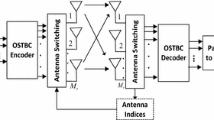Abstract
Land mobile satellite communication systems at Ka/K band (30/20 GHz) are attracting more and more attention to researchers because of its frequency band availability and the possibility of using small earth stations and satellite antennas for the systems. However, the Ka/K-band communications also give significant challenges in the system design due to severe channel impairments expected from the satellite links. In this paper, K-band channel characteristics are studied and compared with those at L band. The channel is modeled as Rayleigh multipath fading with the line-of-sight (LOS) component following a lognormal distribution. The first and second-order statistics of the fading channel are studied. Dual-space diversity reception is investigated to combat the flat channel fading. The bit error rate performance of coherent binary phase shift keying (BPSK) with ideal bit and carrier phase synchronization over the fading channel at K band is evaluated theoretically and verified by computer simulations in the case with and without diversity reception.
Similar content being viewed by others
References
C. Loo, “A Statistical Model for a Land Mobile Satellite Link”, IEEE Trans. on Veh. Tech., vol. 34, pp. 122–127, 1985.
J. S. Butterworth, “Propagation Measurements for Land Mobile Satellite System at 1542 MHz,” Communication Research Center, Department of Communications, CRC Technical Note 723, 1984.
J. S. Butterworth, “Propagation Measurements for Land Mobile Satellite Services in the 800 GHz Band,” Communication Research Center, Department of Communications, CRC Technical Note 724, 1984.
C. Loo, “Digital Transmission Through a Land Mobile Satellite Channel”, IEEE Trans. on Commun., vol. 38, pp. 693–697, 1990.
M.A. Weissberger, An Initial Summary of Models for Predicting the Attenuation of Radio Waves by Trees. U.S. Dept. of Defense, Report no. ESD-TR–81-101, 1981.
P. Balaban and J. Salz, “Optimum Diversity Combining and Equalization in Digital Data Transmission with Applications to Cellular Radio,” IEEE Trans. Commun., vol. 40, pp. 885–907, 1992.
J. Proakis, Digital Communications. Second Edition, New York: McGraw-Hill Book Company, 1989, chap. 4.
N.C. Beaulieu, and A. Abu-Dayya, “Analysis of Equal Gain Diversity on Nakagami Fading Channel, “ IEEE Trans. Commun., vol. 39, pp. 225–234, 1991.
W.C. Jakes, Microwave Mobile Communication. New York: Wiley, 1974.
C. Trabelsi, “RS Codes and Linear Prediction Techniques for Land Mobile Satellite Channels”, M.A.Sc. Thesis, Dept. of Electrical Engineering, University of Ottawa, 1990.
A. Papoulis, Probability, Random Variables, and Stochastic Processes. Second Edition, McGraw-Hill International Book Company, 1984.
P. Beckmann and A. Spizzichino, The Scattering of Electromagnetic Waves From Rough Surface. Artech House, 1987.
R.W. Huck, J. S. Butterworth and E. E. Matt, “Propagation Measurements for Land Mobile Satellite Services”, Proc. 33rd IEEE Veh. Tech. Conf., 1983.
K. Dessouky and T. Jedrey, “The ACTS Mobile Terminal”, JPL SATCOM Quarterly, No. 8, pp. 17–23, 1993.
C. Loo, “Land Mobile Satellite Channel Measurement at Ka Band Using Olympus”, Proc. 44th IEEE Veh. Tech. Conf., Stockholm, Sweden, 1994.
R. M. Barts and W.L. Stutzman, “Modeling and Simulation of Mobile Satellite Propagation,” IEEE Trans. Antennas Propagat., vol. 40, pp. 375–382, 1992.
W. J. Vogel and J. Goldhirsh, “Earth-Satellite Tree Attenuation at 20 GHz: Foliage Effects”, IEE Electron. Lett., Vol. 29, No. 18, pp. 1640–1641, 1993.
W. Lee, Mobile Communications Engineering. New York: McGraw-Hill, 1982.
D. G. Brennan, “Linear Diversity Combining Techniques,” Proc. IRE., vol. 47, pp. 1075–1102, 1959.
W. Zhuang, A. Yongacoglu and J.-Y. Chouinard, “Trellis-Coded Differential MPSK with Multiple-Symbol Viterbi Decoder over Shadowed Mobile Satellite Channel at L and K Bands”, Int. J. Sat. Commun., Vol. 13, No. 3, pp.159–169, 1995.
W. Zhuang, A. Yongacoglu, J.-Y. Chouinard and D. Makrakis, “Performance analysis of EHF land mobile satellite system – channel modeling and performance of coherent MPSK”, Technical Report, Department of Electrical Engineering, University of Ottawa, 1992.
Author information
Authors and Affiliations
Rights and permissions
About this article
Cite this article
Zhuang, W., Chouinard, JY. & Makrakis, D. Dual-Space Diversity over Land Mobile Satellite Channels Operating in the L and K Frequency Bands. Wireless Personal Communications 4, 277–298 (1997). https://doi.org/10.1023/A:1017946628201
Issue Date:
DOI: https://doi.org/10.1023/A:1017946628201




